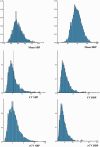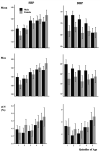Age and sex distribution of beat-to-beat blood pressure variability after transient ischemic attack and minor stroke: A population-based study
- PMID: 33167788
- PMCID: PMC8366176
- DOI: 10.1177/1747493020971905
Age and sex distribution of beat-to-beat blood pressure variability after transient ischemic attack and minor stroke: A population-based study
Abstract
Background: Beat-to-beat blood pressure variability is associated with increased stroke risk but its importance at different ages is unclear.
Aims: To determine the age-sex distribution of blood pressure variability in patients with transient ischemic stroke or minor stroke.
Methods: In consecutive patients within six weeks of transient ischemic stroke or non-disabling stroke (Oxford Vascular Study), non-invasive blood pressure was measured beat-to-beat over five minutes (Finometer). The age-sex distribution of blood pressure variability (residual coefficient of variation) was determined for systolic blood pressure and diastolic blood pressure. The risk of top-decile blood pressure variability was estimated (logistic regression), unadjusted, and adjusted for age, sex, and cardiovascular risk factors.
Results: In 908 of 1013 patients, excluding 54 in atrial fibrillation and 51 with low quality recordings, residual coefficient of variation was positively skewed with a median systolic residual coefficient of variation of 4.2% (IQR 3.2-5.5) and diastolic residual coefficient of variation of 3.9% (3.0-5.5), with 90th centile thresholds of 7.2 and 7.3%. Median systolic residual coefficient of variation was higher in patients under 50 years (4.5 and 3.0-5.3) compared to 60-70 years (4.1 and 3.2-5.2), but rose to 4.5% (3.5-6.9) above 80 years, with an increasingly positive skew. The proportion of patients with markedly elevated blood pressure variability in the top-decile increased significantly per decade (OR 1.72, p < 0.001), after adjustment for sex and risk factors.
Conclusions: Median beat-to-beat blood pressure variability fell in midlife, reflecting loss of physiological, organized blood pressure variability. However, rates of markedly elevated blood pressure variability significantly increased with greater age, suggesting that blood pressure variability may be particularly important in older patients.
Keywords: Age; TIA; blood pressure variability; hypertension; minor stroke; sex; transient ischemic stroke.
Conflict of interest statement
Figures


Similar articles
-
Blood Pressure Complexity Discriminates Pathological Beat-to-Beat Variability as a Marker of Vascular Aging.J Am Heart Assoc. 2022 Feb;11(3):e022865. doi: 10.1161/JAHA.121.022865. Epub 2022 Jan 19. J Am Heart Assoc. 2022. PMID: 35043657 Free PMC article.
-
Prognostic Significance of Blood Pressure Variability on Beat-to-Beat Monitoring After Transient Ischemic Attack and Stroke.Stroke. 2018 Jan;49(1):62-67. doi: 10.1161/STROKEAHA.117.019107. Epub 2017 Dec 11. Stroke. 2018. PMID: 29229726 Free PMC article. Clinical Trial.
-
Physiological correlates of beat-to-beat, ambulatory, and day-to-day home blood pressure variability after transient ischemic attack or minor stroke.Stroke. 2014 Feb;45(2):533-8. doi: 10.1161/STROKEAHA.113.003321. Epub 2014 Jan 9. Stroke. 2014. PMID: 24407950
-
Hypertension and TIA.Int J Stroke. 2009 Jun;4(3):206-14. doi: 10.1111/j.1747-4949.2009.00277.x. Int J Stroke. 2009. PMID: 19659823 Review.
-
Prevalence of patent foramen ovale in cryptogenic transient ischaemic attack and non-disabling stroke at older ages: a population-based study, systematic review, and meta-analysis.Lancet Neurol. 2018 Jul;17(7):609-617. doi: 10.1016/S1474-4422(18)30167-4. Epub 2018 Jun 7. Lancet Neurol. 2018. PMID: 29887162 Free PMC article.
Cited by
-
Blood Pressure Variability and Cognitive Function: a Scoping Review.Curr Hypertens Rep. 2022 Oct;24(10):375-383. doi: 10.1007/s11906-022-01200-w. Epub 2022 Jun 22. Curr Hypertens Rep. 2022. PMID: 35731334
-
Higher sympathetic transduction is independently associated with greater very short-term diastolic blood pressure variability in young healthy males and females.Clin Auton Res. 2023 Aug;33(4):529-532. doi: 10.1007/s10286-023-00949-7. Epub 2023 May 27. Clin Auton Res. 2023. PMID: 37243873 No abstract available.
-
Aortic Stiffness, Pulse Pressure, and Cerebral Pulsatility Progress Despite Best Medical Management: The OXVASC Cohort.Stroke. 2022 Apr;53(4):1310-1317. doi: 10.1161/STROKEAHA.121.035560. Epub 2021 Dec 2. Stroke. 2022. PMID: 34852644 Free PMC article.
-
Blood pressure variability in acute stroke: Risk factors and association with functional outcomes at 1 month.Eur J Neurol. 2024 Aug;31(8):e16314. doi: 10.1111/ene.16314. Epub 2024 May 13. Eur J Neurol. 2024. PMID: 38738545 Free PMC article.
-
Changes in beat-to-beat blood pressure and pulse rate variability following stroke.Sci Rep. 2023 Nov 7;13(1):19245. doi: 10.1038/s41598-023-45479-4. Sci Rep. 2023. PMID: 37935766 Free PMC article.
References
-
- Rothwell PM. Limitations of the usual blood-pressure hypothesis and importance of variability, instability, and episodic hypertension. Lancet 2010; 375: 938–948. - PubMed
-
- Rothwell PM, Howard SC, Dolan E, et al.Prognostic significance of visit-to-visit variability, maximum systolic blood pressure, and episodic hypertension. Lancet 2010; 375: 895–905. - PubMed
-
- Rothwell PM, Howard SC, Dolan E, et al.Effects of beta blockers and calcium-channel blockers on within-individual variability in blood pressure and risk of stroke. Lancet Neurol 2010; 9: 469–480. - PubMed
-
- Webb AJ, Fischer U, Mehta Z, Rothwell PM. Effects of antihypertensive-drug class on interindividual variation in blood pressure and risk of stroke: a systematic review and meta-analysis. Lancet 2010; 375: 906–915. - PubMed
Publication types
MeSH terms
Grants and funding
LinkOut - more resources
Full Text Sources
Medical

